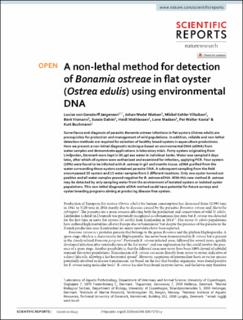| dc.description.abstract | Surveillance and diagnosis of parasitic Bonamia ostreae infections in flat oysters (Ostrea edulis) are prerequisites for protection and management of wild populations. In addition, reliable and non-lethal detection methods are required for selection of healthy brood oysters in aquaculture productions. Here we present a non-lethal diagnostic technique based on environmental DNA (eDNA) from water samples and demonstrate applications in laboratory trials. Forty oysters originating from Limfjorden, Denmark were kept in 30 ppt sea water in individual tanks. Water was sampled 6 days later, after which all oysters were euthanized and examined for infection, applying PCR. Four oysters (10%) were found to be infected with B. ostreae in gill and mantle tissue. eDNA purified from the water surrounding these oysters contained parasite DNA. A subsequent sampling from the field encompassed 20 oysters and 15 water samples from 5 different locations. Only one oyster turned out positive and all water samples proved negative for B. ostreae eDNA. With this new method B. ostreae may be detected by only sampling water from the environment of isolated oysters or isolated oyster populations. This non-lethal diagnostic eDNA method could have potential for future surveys and oyster breeding programs aiming at producing disease-free oysters. | en_US |
